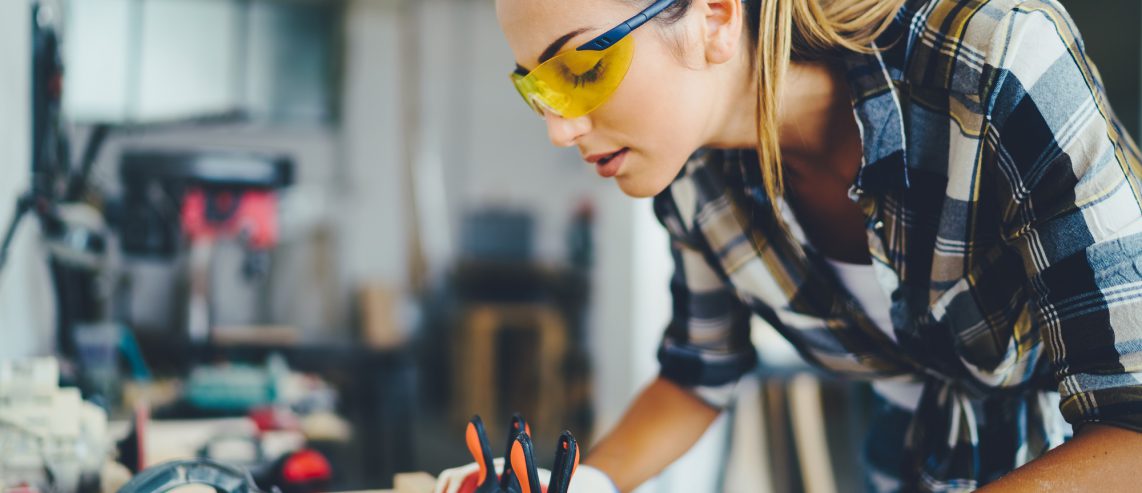You may think of eye safety as something that’s work-related. Welders, chemists, and carpenters all need to protect their eyes. But thousands of people suffer eye injuries at home every year while doing ordinary tasks like cooking and cleaning.
Here’s what you need to know about eye safety at home.
Eye Injuries at Home
You can injure your eyes when you’re doing yard work, hammering a nail, or even popping a champagne cork. According to the American Academy of Ophthalmology, half of all eye injuries in the U.S. happen at home. Men are more likely to get an eye injury than women.
The most common eye injuries are chemical burns, objects penetrating the eye, and blows to the eye.
Never Miss a Beat!
Subscribe to Our HealthBeat Newsletter!
Thank you for subscribing!
You can now select the specific newsletters you'd like to receive.
You are already subscribed.
Subscribe to more newsletters in our email preference center.
Sorry, an error occurred. Please try again later.
Get Healthy Tips Sent to Your Phone!
Overall Advice: Wear Protective Eyewear
The best way to keep your eyes safe is to wear eye protection anytime you’re working on a hazardous project. Doing so can prevent 90% of eye injuries at home. But only 30% of people wear protective eyewear at home.
Prescription eyeglasses aren’t enough to guard against injury. Regular glasses don’t protect your eyes as well as safety goggles do. Safety goggles wrap around your head, provide side coverage, and can go over prescription lenses.
You should wear safety goggles anytime you use lawn equipment, jump-start a car, or operate power tools. Wood chips, yard debris, and screws can fly through the air and into your eyes. Goggles will also protect you from harsh chemical cleaning products or battery acid splashing in your eyes.
Talk to your eye doctor about what type of safety goggles are best for you. Most eye care providers and sporting goods stores sell protective eyewear. They come in different sizes, shapes, and materials.
Remember that any bystanders should also take care of their eyes. If someone is helping you with yard work or at the tool bench, they need eye protection too.
Here are other safety tips for specific situations.
Outdoor Safety Tips for Your Eyes
Eye injuries can happen when you’re mowing the lawn, working on your car, or cleaning your garage. You should:
- Keep items containing chemicals (paint, pesticides, fertilizers) stored properly in a secure area. If they leak, they can cause eye damage.
- Look before you mow. Remove any debris (sticks, rocks, toys) that you see in your path.
- Make sure any spray bottles containing chemicals point away from you before using them.
- Take extra care when tying anything down with a bungee cord. The elastic cords can snap back with great force, causing serious eye injuries.
- Throw away damaged tools. They can splinter and break, causing eye injury.
Indoor Eye Safety Tips
To keep your family’s eyes safe indoors:
- Pad corners on furniture if you have small children in the house. They could run into a sharp corner and hurt an eye.
- Secure area rugs with non-slip pads to avoid slipping and falling. Falls are a leading cause of eye injury in the U.S., especially among adults over 60. Likewise, make sure all stairs are well-lit and have handrails.
- Take extra care with curling irons, hair straighteners, and any other hot appliances near your face. They could burn your eyes and cause serious injury.
Keeping Your Eyes Safe While Cleaning
Chemicals in household cleaning products cause 125,000 eye injuries each year. To keep your eyes safe while cleaning, you should:
- Check that spray bottles point away from you. It’s easy to squirt yourself in the face if you’re not paying attention.
- Don’t mix cleaning products. The resulting chemical reaction could irritate or injure your eyes.
- Make sure you read and follow warning labels on hazardous solvents, drain openers, oven cleaners, and other cleaning products.
Cooking Safety Tips
Eye injuries can happen when you’re fixing meals or throwing a party. Here are some ways to keep safe:
- Close cabinet doors. It’s easy to bump your eye on an open, eye-level cabinet door.
- If you spill something on the floor — especially oil or grease — clean it up before someone falls.
- Pour hot liquids slowly and carefully; they can splash up and hurt your eyes.
- Use grease shields on frying plans to protect your eyes from hot splatters.
- Use slip-proof rugs in the kitchen to reduce falls.
- Wash hands thoroughly after cutting or handling any spicy foods. Residue from jalapenos and similar foods can hurt your eyes.
- When opening champagne, wrap a cloth around the bottle to catch the cork after you loosen it. Champagne corks can fly at 50 miles per hour. Never shake a champagne bottle (which builds pressure) or point it at anyone (including yourself) when opening it.
First Aid in an Eye Emergency
Here’s what to do if you do get an eye injury.
Chemicals in the eye
If you’re wearing contacts and can safely remove them, take them out before flushing the eye. Flush the eye with water for at least 15 minutes. While it is best to rinse the eye with sterile saline, in an emergency, flush the eye with clean running water from:
- A clean container.
- A faucet.
- A shower.
When you’re done flushing the eye, seek medical attention right away. Don’t put other chemicals in the eye to try to neutralize it. Don’t bandage the eye.
Particles in the eye
If you get a bit of dirt or other particle in your eye, try to let your tears wash it out. You can also try washing the eye out with an artificial tear solution. Don’t rub the eye.
If the particle doesn’t wash out, keep your eye closed and lightly bandage it. Seek medical attention right away.
If you’re not sure if the particle is gone, seek medical attention.
A blow to the eye
Apply a cold compress without pressing on the eye. You can use crushed ice in a plastic bag to reduce pain and swelling.
It’s a myth that raw steak will help heal a black eye. It’s more likely to introduce bacteria and cause an eye infection.
If you have severe pain or your vision doesn’t seem right after a blow to the eye, seek medical care right away.
Cuts or punctures to the eye
Don’t wash the eye. If the object that cut your eye is still stuck in your eye or eyelid, don’t remove it. Cover your eye with something rigid, like the bottom half of a paper cup, and seek immediate medical care.
Sources
American Academy of Ophthalmology, Eye Safety at Home: Preventing Eye Injuries, Link
American Academy of Ophthalmology, Eye Injury Prevention, Link
CDC, Tips to Prevent Vision Loss, Link
American Optometric Association, Protecting your eyes at work, Link
American Academy of Ophthalmology, Kitchen Eye Safety Tips, Link
Prevent Blindness, Eye Safety at Home, Link
About UPMC
Headquartered in Pittsburgh, UPMC is a world-renowned health care provider and insurer. We operate 40 hospitals and 800 doctors’ offices and outpatient centers, with locations throughout Pennsylvania, Maryland, New York, West Virginia, and internationally. We employ 4,900 physicians, and we are leaders in clinical care, groundbreaking research, and treatment breakthroughs. U.S. News & World Report consistently ranks UPMC Presbyterian Shadyside as one of the nation’s best hospitals in many specialties and ranks UPMC Children’s Hospital of Pittsburgh on its Honor Roll of America’s Best Children’s Hospitals. We are dedicated to providing Life Changing Medicine to our communities.

